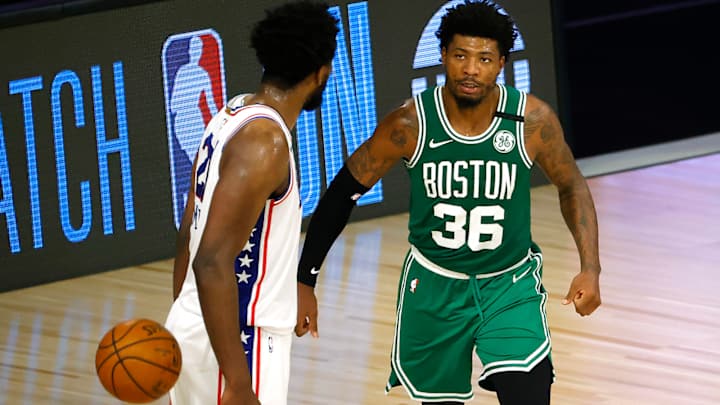The Celtics Are Making the Sixers Confront Their Flaws

The Sixers’ outlook actually looked pretty promising during the first quarter of their Game 2 loss against the Celtics on Wednesday. Joel Embiid was dominating out of the post, Boston had no answer for him, and an injury to Gordon Hayward was at least somewhat offsetting the loss of Ben Simmons. After Philly jumped out to an early 14-point lead, Boston quickly began dismantling the Sixers to the tune of a 41-point turnaround, winning by 27. Thirty-six minutes after its hot start, Philly looked like a team on the brink of much more than a disappointing playoff exit.
Questions have followed the Sixers all season long after the front office remade the roster for the umpteenth time last offseason. It seems like a different lifetime now, but it was only two seasons ago when Philly was an up-and-coming team with one of the best starting fives in the league and a much-hyped No. 1 pick recovering from an injury on the bench. Recapping everything that’s gone wrong since is its own saga, but the ensuing roster machinations have been largely unsuccessful, and the Sixers’ flaws have been especially laid bare against the Celtics.
Losing Simmons was always going to be tough to endure. But isn’t it fair to ask for more from Tobias Harris and Al Horford? Harris and Horford combined to make over $60 million this season. They combined to score only 17 points in a must-have Game 2, or one point less than Josh Richardson scored by himself. Harris and Horford didn’t become bad players overnight. But they were questionable fits from the moment they were brought to Philly. And when you consider the context of what the Sixers gave up to sign them—the assets lost in Harris trade, letting J.J. Redick walk, and the abundance of cap room—it makes their performances Wednesday exponentially more frustrating.
Horford was passive. He can’t really anchor lineups without Embiid because of the overall lack of depth, and the two have never been outstanding on the court together, even without the added awkwardness of Simmons. Harris was inefficient, didn’t look comfortable playing a two-man game with Embiid, and despite his team desperately needing some outside shooting, he attempted only two threes, missing both. (The Sixers as a team shot 5-of-21 from beyond the arc. Jayson Tatum alone shot 8-of-12.)
The blame doesn’t solely fall on the shoulders of Harris and Horford. Embiid was great in the first quarter, but his impact waned as the game went on. It’s hard to separate his own offensive capabilities from what’s happening around him, but Embiid’s two-way effort is 100 percent his responsibility. Embiid, whether by design or for energy conservation, did his best to never leave the paint on defense. That meant dropping deep on every pick and roll, allowing Boston’s wing players to frequently walk into wide-open threes. By my count, the Celtics hit seven practically uncontested threes because of Embiid’s decision to hang in the paint. And it’s not like he was sagging off of bad shooters. If anything, Boston could have even taken more advantage of the head-scratching scheme.
The series is obviously not over. And it would be a little unfair to judge this Sixers team definitively without Simmons. But Philly didn’t just lose. It looked listless and completely overmatched. And it’s not like the Celtics snuck up on anyone in the East as one of the teams they’d have to go through to win the conference. The fact that Philly could look so flat and two highly paid players could put up such disappointing efforts against a rival is creating a cause for concern this series otherwise wouldn’t have if these losses were at least hard fought.
The bubble may be a complicated time to make long-term decisions about any team. But it also means teams have nowhere to hide. The Celtics aren’t dominating because of a homecourt advantage. The Sixers aren’t losing because they lack rest. There are no excuses other than simply not meeting the moment.
Two years ago, when the Sixers lost to the Celtics in the playoffs, they were still on the upswing. The core was young and homegrown. The front office had cap and roster flexibility. No relationships were soured because of bitter defeats. Two years later, and the outlook is almost the exact opposite. That’s how quickly life can change in the NBA. On Wednesday, it only took the last three quarters to show what this Sixers’ team is, at best, flawed. How they respond will likely determine several people’s futures.

Rohan Nadkarni covers the NBA for SI.com. The Mumbai native and resident fashion critic has written for GQ.com, Miami Herald and Deadspin.